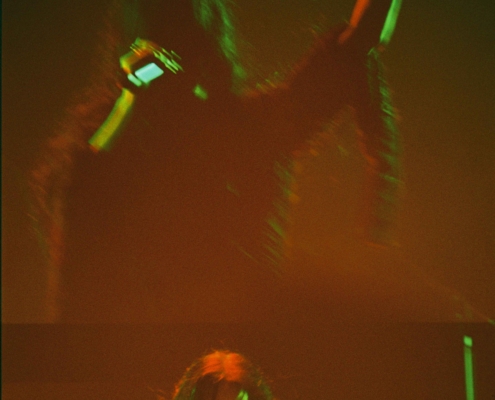Your heritage is clearly a subject matter which you explore throughout your works and practice. You studied Fashion Design Knitwear at Central Saint Martin’s (CSM), however in your debut during An Anticlone Takeover II in Newington, you have since created sculptures. What made you explore this medium?
During my making process I always used a range of mixed media to explore my ideas, having a background in makeup and SFX I decided to incorporate silicone into the garments. I gravitate towards an initial emotive response to my research. Through character building, I wanted my bodysuits to have a skin-like appearance, to achieve this I created 3D sculptures, speculative organisms that emulated my ideas of second skin. These were later utilised to create silicone imprints on the garments. I showed Sade these sculptures and we shared the realisation that the pieces could stand alone by themselves.
Shortly after graduating from CSM, you were featured by Anticlone Gallery with support from the Founder. In comparison to your CSM experience, how does it feel debuting as a post-graduate and showcasing new works for Frieze, Takeover III?
Despite being 4 years in the making, my final collection felt as if you blinked you would miss it; the end process was so fast. As a student I had high expectations and I felt would be just as appreciated as the final outcome. By being given this opportunity to exhibit at Anticlone, I feel my work can be seen and appreciated from another perspective in more detail. I have always had a very clear vision of how I wanted my work to be viewed, especially within an exhibition space. Being given this opportunity to exhibit at Takover III is perfect during this transition.
What do you feel your work represents, and what is the process behind your creations?
My work is an autoethnographic exploration of mental health and generational trauma within my family. Looking at personal stories within my family and collecting documentation, I have had open conversation surrounding their struggles which I felt they wouldn’t have had otherwise. Through black utopian studies and ideas of matrilineage, I have collected parts of my history that I identify with closely. I initially start with writing and research, this has been integral to laying the foundations of every project I approach. Through my art, I am actively placing myself within history. I aim to use these experiences as a tool for healing and create new avenues for exploration of black study.
You have been involved in the avant garde and underground scene of London, how has this influenced your works?
The underground avante garde scene in London has allowed me to express my interest in the dark and macabre. I move around these spaces under the alias ‘AKASHA’. It has been a great tool to bring out my confidence and meet other creative minds. In regards to my personal work, it hasn’t influenced it as I prefer to keep these worlds separate. My work is me when I am most vulnerable and naked therefore I use my birth name ‘Krissie Marie Heliodore’. I handle it with care. My underground persona is a character for that scene and a world apart; it makes more sense to keep them separate.
Telling stories through your art is apparent, identity is a common theme,what is the message you are trying to communicate through your practice?
My approach for each project always starts from a personal place. As a black artist, I feel the importance of shedding light on black history and the struggles of my ancestors. I personally feel it’s disingenuous for me to create art based on historical tragedies I was not physically present for. However, I do feel the effects of these tragedies as they have manifested in other ways through generations, this I can definitely attest to. Mental Health and its taboos have always been a struggle for me and I use art as my therapy, so there is definitely a yearning to find myself by creating work surrounding my family. Therefore I create art that speaks to my experience in hopes that it opens up conversations that I feel are quite difficult for the majority of black families.
 https://www.nastymagazine.com/wp-content/uploads/2023/10/Copia-de-1-scaled.jpg
2560
1707
admin
https://www.nastymagazine.com/wp-content/uploads/2015/02/new-logo-basker-WHITE4.png
admin2023-10-31 12:32:352023-10-31 12:37:23Lila Tirando a Violeta / The Noise of Waters
https://www.nastymagazine.com/wp-content/uploads/2023/10/Copia-de-1-scaled.jpg
2560
1707
admin
https://www.nastymagazine.com/wp-content/uploads/2015/02/new-logo-basker-WHITE4.png
admin2023-10-31 12:32:352023-10-31 12:37:23Lila Tirando a Violeta / The Noise of Waters











